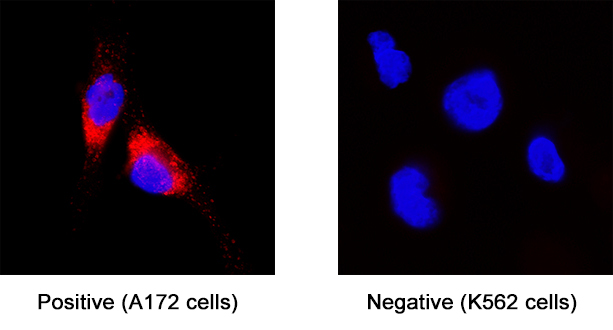Human Glypican 1 Antibody Summary
Asp24-Ser530
Accession # P35052
Applications
Please Note: Optimal dilutions should be determined by each laboratory for each application. General Protocols are available in the Technical Information section on our website.
Scientific Data
 View Larger
View Larger
Glypican 1 in A172 Human Cell Line. Glypican 1 was detected in immersion fixed A172 human glioblastoma cell line (positive) and not K562 human chronic myelogenous leukemia cell line (negative control) using Mouse Anti-Human Glypican 1 Monoclonal Antibody (Catalog # MAB4519) at 8 µg/mL for 3 hours at room temperature. Cells were stained using the NorthernLights™ 557-conjugated Anti-Mouse IgG Secondary Antibody (red; Catalog # NL007) and counterstained with DAPI (blue). Specific staining was localized to cytoplasm. View our protocol for Fluorescent ICC Staining of Cells on Coverslips.
Reconstitution Calculator
Preparation and Storage
- 12 months from date of receipt, -20 to -70 °C as supplied.
- 1 month, 2 to 8 °C under sterile conditions after reconstitution.
- 6 months, -20 to -70 °C under sterile conditions after reconstitution.
Background: Glypican 1
The Glypicans (glypiated proteoglycans) are a small multigene family of GPI-linked proteoglycans that play a key role in growth factor signaling (1, 2, 3, 4). There are six known mammalian Glypicans. They all share a common-sized protein core of 60 - 70 kDa, an N-terminus which likely forms a compact globular domain, 14 conserved cysteines that form multiple intrachain disulfide bonds, and a number of C-terminal N- and O-linked carbohydrate attachment sites. Based on exon organization and the location of O-linked glycosylation sites, at least two subfamilies of Glypicans are known, with one subfamily containing Glypicans 1, 2, 4 and 6, and another subfamily containing Glypicans 3 and 5 (3, 5). Human Glypican 1 (GPC-1) is synthesized as a 558 amino acid (aa) preproprecursor that contains a 23 aa signal sequence, a 507 aa mature segment, and a 28 aa C-terminal prosegment (6, 7). There are two potential N-linked and four potential O-linked sites for glycosylation or glycanation. There are potentially two heparan sulfate (HS) modifications on GPC-1 that could contribute to a native molecular weight of approximately 200 kDa (7, 8, 9). Mature human GPC-1 shares 91% aa identity with mature mouse GPC-1. There are two potential splice variants of human GPC-1. Both show an alternate start site at Met73, while one has an additional 65 aa substitution for the C-terminal 264 amino acids (10, 11). Cells known to express GPC-1 include neurons, smooth and skeletal muscle cells, keratinocytes, osteoblasts, Schwann cells, immature dendritic cells, and tumor, plus tumor-associated vascular endothelial cells (8, 9, 12 - 15). The function of GPC-1 is complex and varied. As a proteoglycan, it appears to make use of its HS adduct to impact select growth factor activity (16). This is accomplished by having juxtramembrane HS attachment sites, and a flexible, GPI-linkage (17). Data suggests GPC-1 and sulfation enzymes may collaborate to regulate FGF signaling. HS modules that are rich in 2-O- and 6-O- sulfate upregulate FGF-2 activation of FGFR1c (18). Similarly, FGF-1 requires both 2-O- and 6-O-sulfation to bind to FGFR2c and 3c. By contract, FGF-1 requires no sulfation to bind to FGFR2b, and FGF-8b needs only 6-O-sulfation to activate FGFR3c. Thus, many FGF receptor isoform specific effects may be attributed to an interaction between Glypican family members and the cell sulfation system (19).
- Song, H.H. and J. Filmus (2002) Biochim. Biophys. Acta 1573:241.
- Fransson, L-A. et al. (2004) Cell. Mol. Life Sci. 61:1016.
- De Cat, B. and G. David (2001) Semin. Cell Dev. Biol. 12:117.
- Lamoureux, F. et al. (2007) BioEssays 29:758.
- Veugelers, M. et al. (1999) J. Biol. Chem. 274:26968.
- GenBank Accession # P35052.
- David, G. et al. (1990) J. Cell Biol. 111:3165.
- Lories, V. et al. (1992) J. Biol. Chem. 267:1116.
- Lories, V. et al. (1989) J. Biol. Chem. 264:7009.
- GenBank Accession # EAW71184.
- GenBank Accession # EAW71183.
- Chernousov, M.A. et al. (2006) J. Neurosci. 26:508.
- Wegrowski, Y. et al. (2006) Clin. Exp. Immunol. 144:485.
- Qiao, D. et al. (2003) J. Biol. Chem. 278:16045.
- Kayed, H. et al. (2006) Int. J. Oncol. 29:1139.
- Selleck, S.B. (2006) SciSTKE, April 4:pe17.
- Qiao, D. et al. (2003) J. Biol. Chem. 278:16045.
- Su, G. et al. (2006) Am. J. Pathol. 168:2014.
- Allen, B.L. and A.C. Rapraeger (2003) J. Cell Biol. 163:637.
Product Datasheets
FAQs
No product specific FAQs exist for this product, however you may
View all Antibody FAQsReviews for Human Glypican 1 Antibody
There are currently no reviews for this product. Be the first to review Human Glypican 1 Antibody and earn rewards!
Have you used Human Glypican 1 Antibody?
Submit a review and receive an Amazon gift card.
$25/€18/£15/$25CAN/¥75 Yuan/¥2500 Yen for a review with an image
$10/€7/£6/$10 CAD/¥70 Yuan/¥1110 Yen for a review without an image




